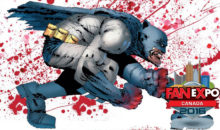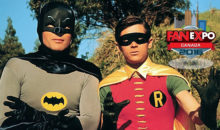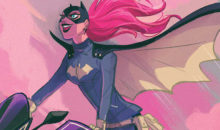How a Comic Book Helped Me Overcome My Mugging – Dark Night: A True Batman Story
They say write what you know. But how do you write when what you know terrifies you?
If you’re anything like Paul Dini, you wait 20 years until the love from others and self-acceptance that comes with age allows you to recount in comic form the horrifying experience of being beat to near-death by muggers, and the emotional road to physical and mental recovery.
Multimedia writer Paul Dini is the scribe responsible for, among other things, penning the celebrated Batman: The Animated Series, writing the first two entries in the Batman: Arkham video games, and gifting the world with the insanely popular anti-hero, Harley Quinn. Few writers understand the characters of Gotham City quite like Dini does, and even less have impacted their mythos the way he has. In Dark Night: A True Batman Story, Dini sheds light on how these characters have impacted him.

Dark Night is the story of Dini’s violent mugging in 1992, and the existential crisis that followed. Bloodied and broken, the depressing irony of a Batman writer being jumped by petty crooks did not escape Dini, who soon after began questioning his life’s work of writing stories about good guys in capes. That night, there were no masked vigilantes swooping in to save him. No justice. No vengeance. No Batman.
Dini’s deepest anxieties frequently emerged via antagonistic apparitions of Batman’s villains in the months following his attack. In the book, when the writer views his facial scars in the mirror, he sees Two Face and is reminded of his ugliness. When he thinks of going back to work, the Joker appears, laughing and insisting it’s best to keep playing video games and drinking himself sick every night. In Dark Night, Dini writes like a victim testifying with heartbreaking recollection. Artist Eduardo Risso’s work beautifully accompanies the somber writing, triumphing in its ability to visually weave together Dini’s vibrant hallucinations with the depressing tones of his real world. Together, these artists tell a gripping and very grounded Batman story.

In time, Dini was able to overcome his trauma and doubts, despite a conscious effort to kill his darlings and leave animation behind, and eventually returned to the world of the Caped Crusader. Like Bruce Wayne, Dini learns to find drive and meaning in his personal tragedy, instead of indulging in the misery the way the villains he writes tend to. I wouldn’t dare spoil the events that lead to his healing – for those you really ought to read the book – but know that Dark Night is an inspiring story of perseverance. And for anyone who has ever been assaulted, it’s also deeply relatable.
Eight years ago, I was cornered and mugged at knife-point walking home late one evening. Some jerk, way bigger than my friend and I, had us cornered. He wanted cash, he wanted phones, and he wanted weed. When we told him we didn’t have drugs he got aggravated and showed us his knife, poking it against my torso. Before I knew it he was gone, along with half of my things, but I could still feel his knife pressed against my stomach for days.
My mugging was nowhere near as traumatic as Dini’s or the countless others who have surely suffered worse, but nights like that have the effect of haunting you for years. Following the attack I hated going outside at all, afraid that it would happen again – that it would be worse this time. Friends still ask why I walk so fast, or why I look around so much. I joke that my speed is because of my long legs, and that I’m looking around to enjoy the sites, but whenever I’m out I worry that someone is pursuing again. Waiting until I’m vulnerable. I can’t stand waiting for people at an outdoor meet up location because it means I’m standing still, and that blade could press up against me again at any second. Funny how one prick with a knife fucked up my ability to engage with people for years.

No hero was there for me that day in 2008, but Paul Dini is now. In one of many fourth wall breaking moments within Dark Night where Dini defends his choice to write the book, a character asks him, “What makes you think that anyone else could possibly give two shits for your little ordeal?”
Dini’s in-book counterpart replies, “I asked myself that for a long time and the answer I always came back to was, ‘I care.’ … If someone is able to find something to identify within my story, then maybe it was worth telling.”
Therein lies the strength of Dark Night: A True Batman Story. In opening up and making himself vulnerable, readers who have suffered their own traumas are allowed to share in the misery and feel strength in solidarity. Dini and Risso offer power to their readers, explaining that the Caped Crusader may not exist, but the ideals, drive, and spirit of the character are things worth believing in.
Dini discovers that you need to be your own hero instead of waiting for a man in a mask to fly in, but there’s nothing wrong with allowing others to help you become that hero. For Dini, it was the fans of his show and support of his loved ones that got him back on track to finish Batman: Mask of the Phantasm. For me, it’s Dini’s book that taught me I don’t need to lock my fears away from the people who care about me.
Does this mean I should start taking dark alley shortcuts throughout town? Of course not (everyone knows what happened to the Wayne family, after all). But maybe I can start being honest to my friends about the real reason I walk so fast at night and accept the empathy they might offer. If Dini can reach out and find catharsis in revisiting the worst night of his life, we should all be allowed to open up about our vulnerabilities, too.
For 21 years Batman comics have let me follow Bruce and help him overcome his greatest enemies. With Dark Night, I’ve found a Batman story that has forced me to face my own demons.







